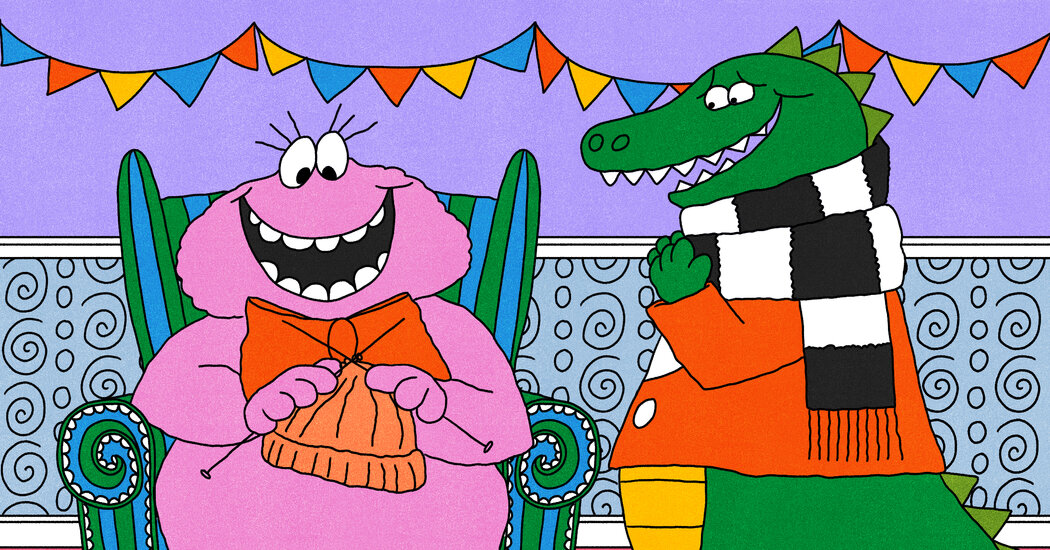
On Christmas Eve in 2013, Elisa Stead, an American living abroad in Iceland, was ready to celebrate the holiday with her fiancé and his family. But when she tore open the wrapping on his gift for her, she was disheartened to discover what lay inside: a car-window scraper. Sure, she lived in a frosty place, but she didn’t own a car. Receiving such a thoughtless gift made for an unhappy holiday, and the relationship ended within the year.
Two years later, Stead was living in Norway and recently engaged to a different man. She still felt detached from the magic of Christmas so her new fiancé, Tore Græsdal, made it his mission to revive it for her. But that didn’t mean spending lavishly. Instead, Græsdal recorded himself reading Norwegian folk tales, and added in a couple of sound effects, like a crackling fire, to make it feel cozy.
The recordings signified their future together in her adopted country and her embrace of a new culture and language. Stead, who traveled often for work and didn’t yet live with her fiancé, took comfort in listening to the folk tales when she and Græsdal were apart. Years later, the couple still return to the recordings, now playing them for their children. Græsdal’s gift that year was priceless in both senses: It cost him nearly nothing to create, and it was so unique no price could be placed on it.
The holiday season is a time of high spirits and spirited spending. As people deal with the pressure of finding the perfect gift for their loved ones, many gifters respond by throwing money at the challenge. One survey found that Americans plan to spend an average of $831 on gifts this year; more than half of them incurred credit card debt to cover last year’s costs, and nearly a third of those are still paying that debt off. According to experts, this approach may be misguided.
Givers “tend to overspend each time they set out to purchase a meaningful gift,” Francis J. Flynn and Gabrielle S. Adams, two professors at Stanford’s Graduate School of Business, wrote in a study. They found that, while “gift givers assume that more expensive gifts convey a higher level of thoughtfulness,” recipients don’t see them that way.
Instead, it’s worth considering gifting options that, like Græsdal’s, cost little or nothing, but can be especially cherished because they demonstrate the time and effort that have gone into a token worthy of the giver’s affection for the recipient.
People tend to overestimate the correlation between a gift’s monetary value and its emotional impact, explained Julian Givi, an assistant professor of marketing at West Virginia University’s John Chambers College of Business and Economics. “These no-cost gifts that people are creating from scratch, they’re conveying thoughtfulness and care and appreciation,” he said, all of which mean more than a receipt.
Givi also found that experiences are often better appreciated than material gifts. Some experiential gifts cost money but it is possible to give ones that don’t: a scavenger hunt, a personalized walking tour or hike, teaching someone a skill they’ve expressed interest in. Such presents also tend to generate less physical and financial waste — another concern this season — than material gifts.
Some of the best gifts draw on shared interests. Megan O’Hara and Jonathan Krieger met at a board game speed-dating event in Boston in 2019. The year after they started dating, O’Hara gave Krieger a board game based on a book he had written. She didn’t have a background in game design, but drew on games they enjoyed playing together. She made the cards on the graphic design website Canva, printed them out and used a shoe box as the game’s container. It was, Krieger said, one of the best gifts he’s ever received. (Perhaps the best known example of such a gift is the New York Times game Wordle, which was created as a present by a software engineer for his partner, but ended up being a gift to millions of others.)
While homemade gifts can seem daunting to those who don’t consider themselves crafty, it helps to shift the idea of what those gifts can look like. The key is doing something personal, such as writing someone a letter, song or poem, or recording some favorite memories. If creating something original feels overwhelming, curation is another way to give a thoughtful gift, whether it’s making a mixtape (or, these days, more likely a Spotify playlist), or compiling and sharing favorite recipes.
“Givers refrain from going with the sentimental thing more often than recipients would prefer,” Givi said. “People shouldn’t be as afraid to give them.”
The value of such gifts is found in their enduring resonance. When I was growing up, my grandmother and I shared a love of reading, and she often gave me books from her extensive personal collection as holiday gifts. But one year, when I was a teenager, I unwrapped a bundle of nine typed pages labeled “Favorite Books.”
She’d listed over 30 books and, with each suggestion, she shared a paragraph about her relationship to the book — when she encountered it, why it had stuck with her or a favorite quote. That year, I wondered why she hadn’t just given me another book, which I could have happily cracked open in front of the fireplace that day.
But her desire to share her memories of the books with me was an unforgettable gift. I didn’t end up getting to most of the books while she was alive, so having this special list offers me a way to keep reading alongside her.






